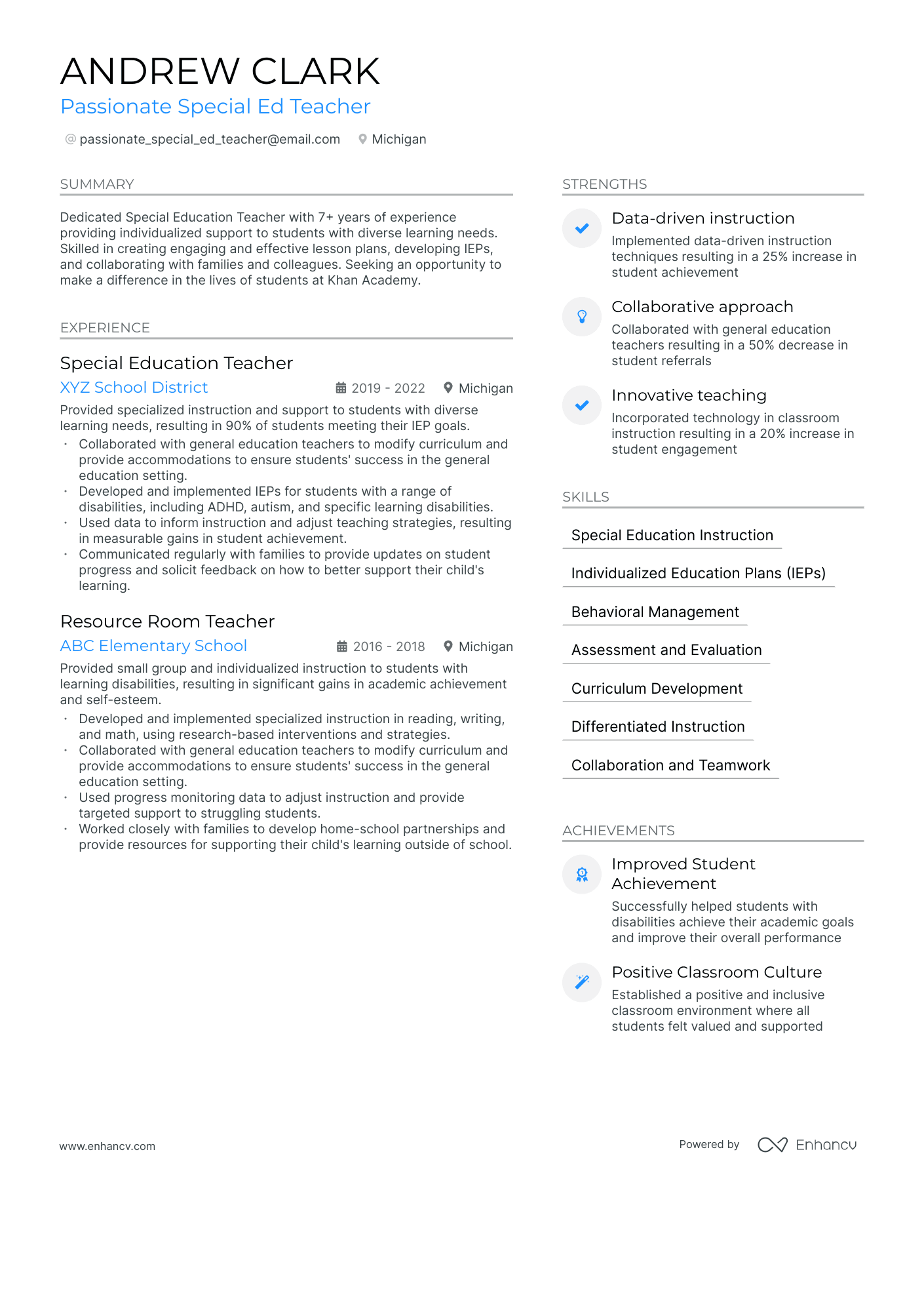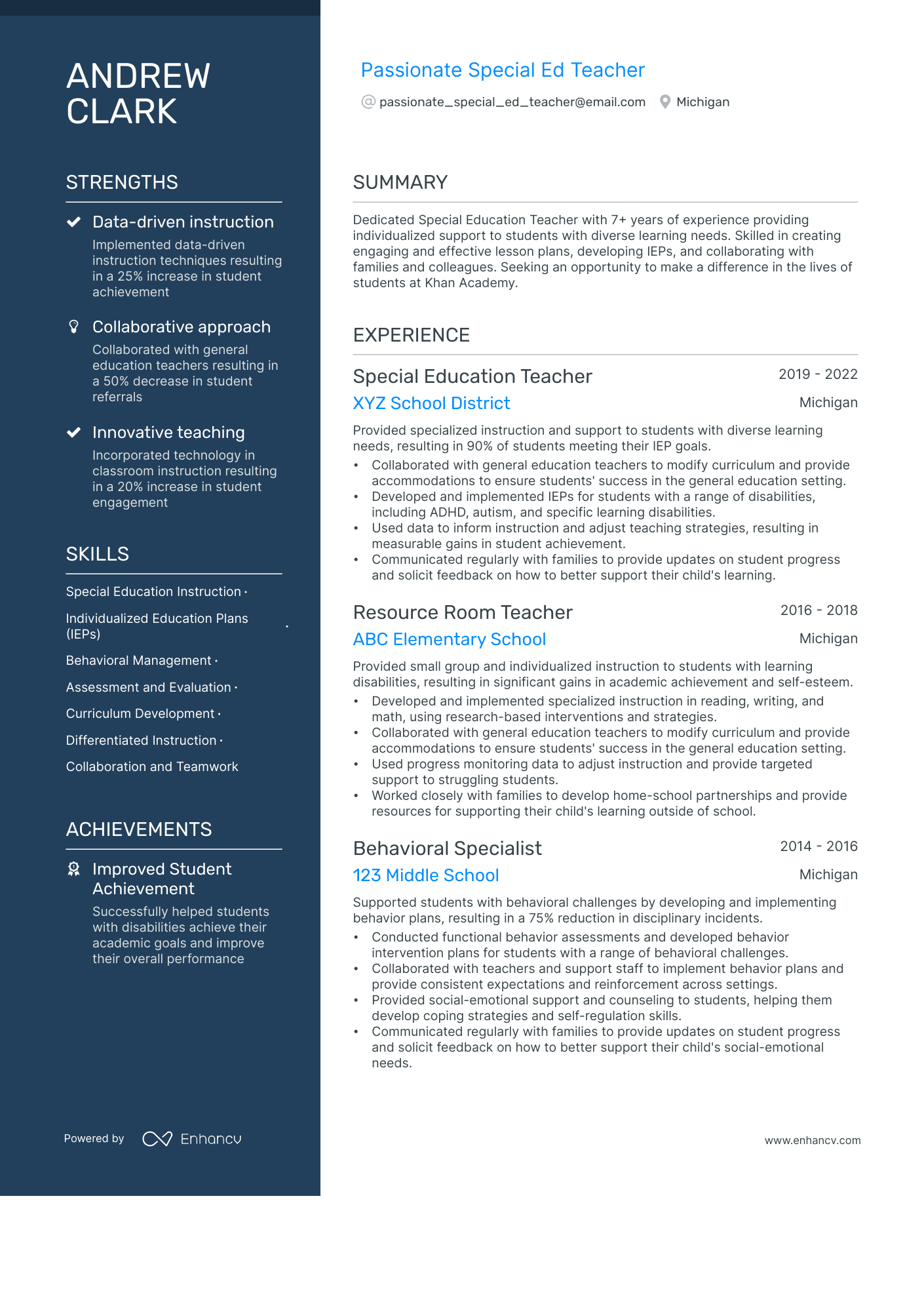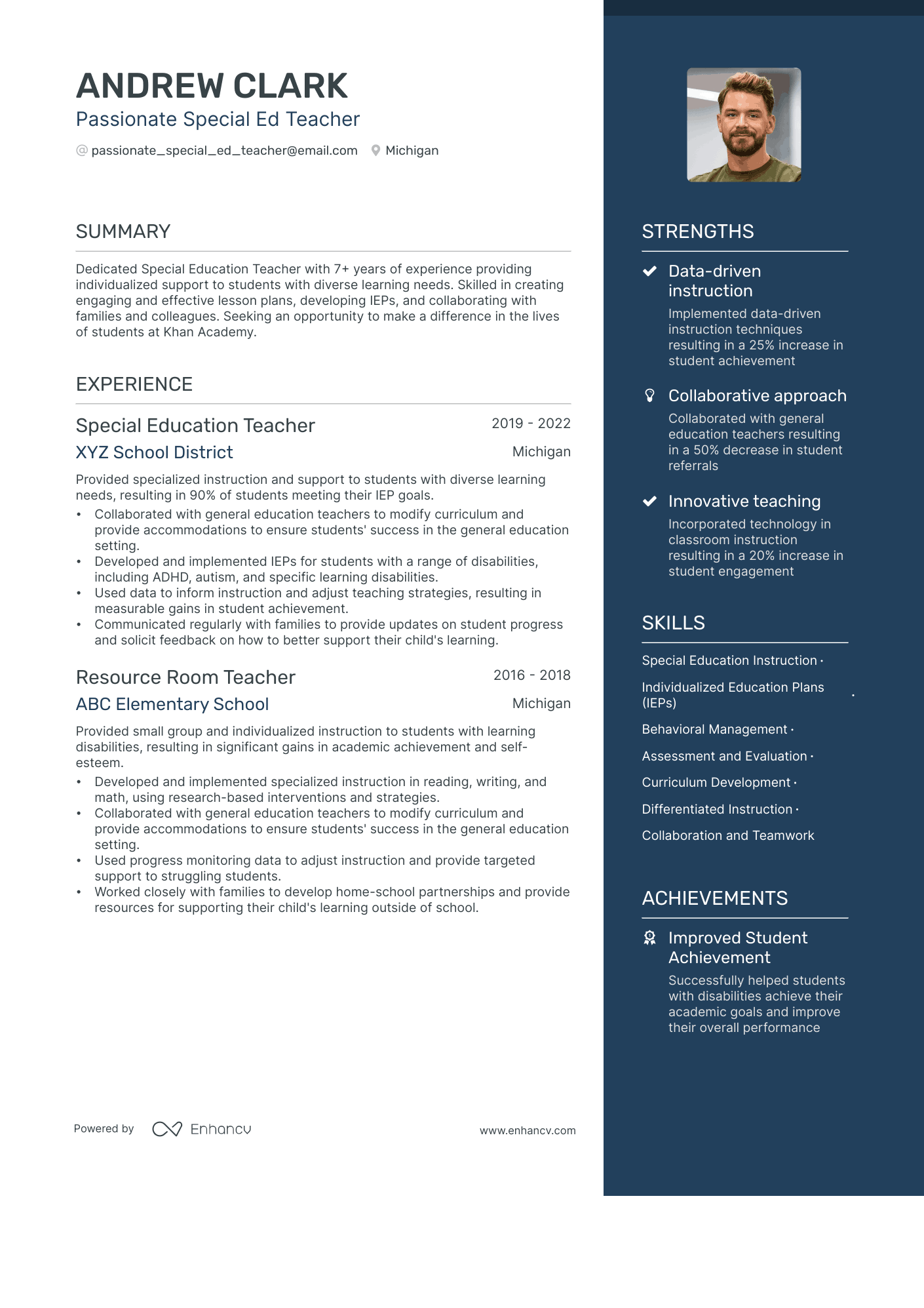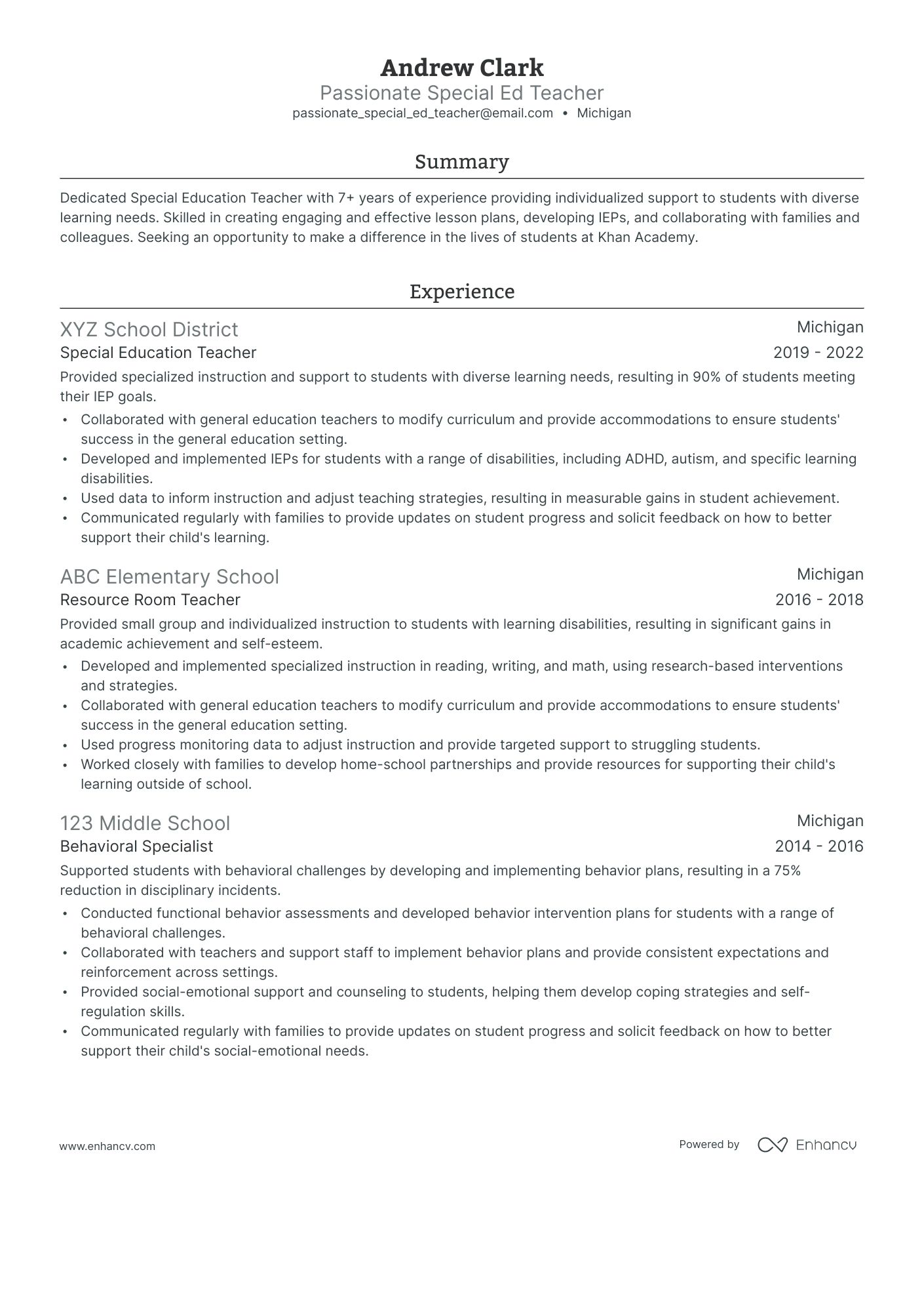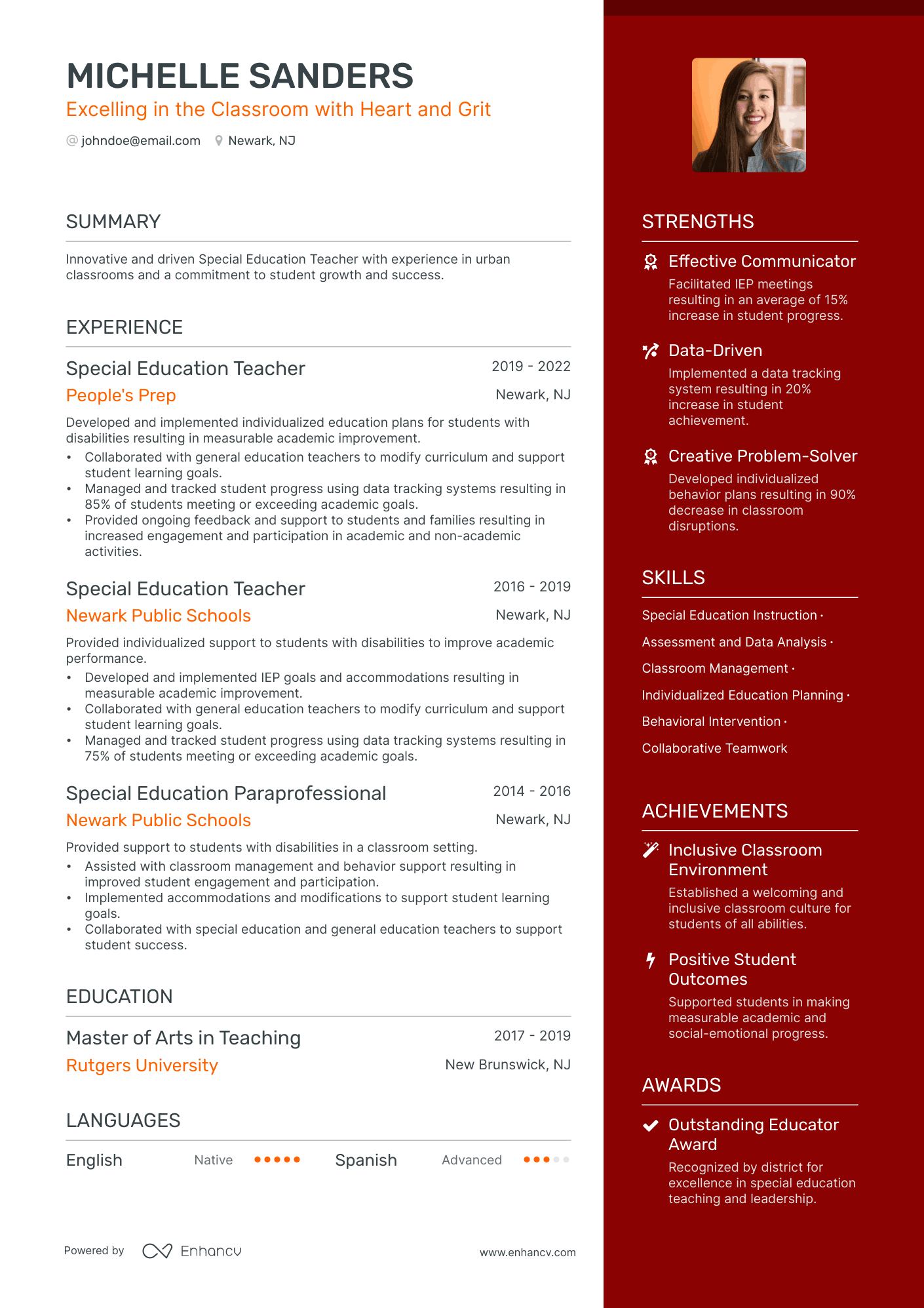As a special education teacher, you're often the unsung hero.
It takes more than simple pedagogical expertise to thrive at your job. Your highest aim is for your students to reach their full potential. And you're often successful at that through patience, empathy, and collaboration.
However, when you send out your special education teacher resume, you may feel a bit undervalued when you send dozens without getting a single callback.
In today's guide, we'll show you:
- How to craft a resume that illuminates your special education teacher skills and impact
- Real-world template examples to model your own resume after
- Best way to quantify your accomplishments and make your resume stand out to potential employers.
Ready to craft a standout resume that secures the job you have your eyes on?
Let’s jump right in.
Explore other relevant to education resumes:
- Teacher Resume Examples
- Social Studies Teacher Resume
- Creative Art Teacher Resume
- English Teacher Resume
- Elementary Teacher Resume
- High School Teacher Resume
- Preschool Director Resume
Special education teacher resume example
What gives this resume sample an edge:
- The example resume has a clean, intuitive layout and formatting style. That makes it easy for recruiters to quickly scan and absorb.
- The applicant gave specific examples of her achievements with measurable data and skills, instead of making vague claims.
- Throughout the resume, the applicant touched on successful parent-teacher partnerships. That’s a crucial aspect of student progress in special ed environments.
How to format a special ed teacher resume
Your resume isn't just a dull list of skills and experiences — it's your professional story. For special education teachers, where the roles are as nuanced as they are crucial, a well-formatted resume can make all the difference.
Professionalism and attention to detail are two essential qualities in your line of work. Ensuring that your resume is clear, organized, and easy to read is an easy way to show just that! You can only do that by using the right resume format.
A job-winning resume for a special education teacher must:
- Use a reverse chronological format: To best showcase your expertise and career growth, be sure to start with your most recent position and work your way backward.
- Feature a header with contact details: Place a prominent header at the top of your resume. Then, add easy-to-read contact details to make your resume more personable.
- Highlight key resume sections: Place emphasis on sections like work history, teaching qualifications, skills, or specialized certifications. Tailor these sections to match the specific job you're applying for.
- Keep your resume concise: Unless you have decades of experience as a sped teacher, it’s best to keep your resume’s length to one or two pages. Clarity and brevity are key in getting recruiters to fall in love with your application.
Pro Tip
Unless otherwise stated in the job ad, PDF is the best format to use in your special education teacher application. It's the ideal way to maintain consistent formatting across different devices and platforms, which is especially true for modern, visually-rich resumes.
The top sections on a special ed teacher resume:
- A header section to introduce yourself with essential contact details and set the resume's tone.
- A summary section to capture your career essence and entice headhunters to delve deeper into the remaining sections.
- An experience section to chart your professional growth and emphasize your crucial contributions within the school.
- A skills section to spotlight your unique abilities and outstanding talents in the classroom.
- Education and certifications sections to validate your long expertise with formal training and credentials.
What recruiters want to see on your resume:
- Proven expertise in tailored teaching strategies for diverse learning needs
- Measurable achievements showcasing progress and improvements in student benchmarks
- Experience working with parents, general education teachers, and therapists to provide holistic support
- Capacity to address individual challenges and develop personalized learning plans for students
- Relevant special education licenses and certifications, highlighting your depth of expertise and dedication.
How to write your special education teacher resume experience
Your resume experience is what brings your resume to life. It’s where you’ll highlight your professional journey and the impact you’ve made in the lives of your students.
But, in order for your experience to be captivating, you must go beyond adding a list of job titles and dates.
To craft an eye-catching experience section, you have to:
- Focus on achievements and skills over duties
- Optimize your bullet points with industry-specific keywords
- Use precise numbers and statistics to quantify your achievements
- Maintain a consistent format for dates, titles, and school names.
Let’s look at these two special education teacher resume examples:
- •Employed standard teaching aids to assist in class sessions.
- •Participated in regular meetings with other staff members.
- •Employed standard teaching aids to assist in class sessions.
Special education teaching is a tough job that needs unique skills and knowledge. Yet, the example above didn’t emphasize any of that to make the candidate stand out.
What can we do to improve that in three simple steps?
- Avoid generic role descriptions. Featuring irrelevant duties in the experience section is a sure way to get ignored. For distinct roles such as special education teaching, pinpointing accuracy in responsibilities is a must.
- Showcase concrete outcomes. Recruiters always value tangible results when assessing a special education teacher’s impact in the classroom. Add concrete numbers to make your achievements more attractive.
- Use action verbs. Action verbs will highlight your confidence and add energy to your accomplishments. Demonstrate your impact by selecting action verbs that match your contributions.
Once you make these changes, your sped teacher resume should look like this.
- •Managed a classroom of 15 students, tailoring strategies for each, achieving a 90% milestone success rate.
- •Participated in bi-weekly meetings, coordinating with therapists and educators to ensure student progress.
- •Utilized specialized teaching tools, resulting in a 20% boost in student engagement and comprehension.
How to quantify impact on a special education teacher resume
As a special education teacher, you often compete in a sea of candidates with matching skills and qualifications. Unfortunately, this makes it tricky for you to stand out from the crowd.
The solution?
You must highlight your direct impact on your special needs students through tangible metrics. That helps you efficiently capture recruiters’ attention and prove your results-driven mindset.
Here are a few questions to help you promote yourself as a valuable addition to any school:
- Did you craft and implement any individualized educational plans (IEPs)? If so, what was the goal attainment rate for these IEPs?
- Did you use any behavioral techniques to reduce disruptions in the classroom?
- How often did you conduct parent-teacher meetings? And did increase parental involvement with their children?
- How many special needs students did you support and adapt strategies for?
- How many professional workshops on special education techniques did you participate in?
- Were you able to boost student engagement by incorporating assistive technologies?
- How many therapists and specialists did you cooperate with? Did these collaborations lead to notable improvements in student performance?
How do I write a special ed teacher resume with no experience
Let’s be honest - it’s not easy to break into the field of special education when you lack experience.
You know you’re qualified and ready for the position. But, hiring managers encounter such claims on every special needs teacher resume they review. So to rise above the rest and get noticed, you must show great promise.
How do you leave a mark on recruiters without experience?
By reshaping your resume to radiate drive, readiness, and potential. Here’s how to do that in a few simple steps:
- Use a hybrid resume format that emphasizes skills and qualifications upfront.
- Start with a resume objective that displays enthusiasm and desire to excel as a special education teacher.
- Emphasize skills like patience, communication, or teamwork from other roles or work experiences.
- Focus on relevant coursework, projects, or research related to special education.
- List any unpaid work or internships as long as they're related to education or caregiving.
- Include any training or workshops attended, even if not directly linked to teaching.
Special education resume skills: how to list your hard skills and soft skills
Without the teacher’s touch, the classroom is just a room of books. And without skills, your resume is merely a list of words on paper.
In the skills section, you will highlight your best qualities and tie them directly to the job ad.
There are two types of skills you should be aware of:
Soft skills are non-measurable qualities that help you foster a deeper bond with your students. Empathy, patience, adaptability, and strong communication are all essential interpersonal skills in your field.
On the other hand, hard skills are the concrete tools and techniques you’ve picked up on the job through practice. This includes special therapy training, knowledge about IEPs, and using assistive technologies.
Now, to really make your resume stand out:
You have to align your skills with the specific requirements of the job description. For example — if a school is seeking proficiency in sign language, put that front and center.
Also, quality always trumps quantity. So make sure to keep your list between 8 to 12 skills matching the job description and your personal experience.
Best hard skills on a resume for a special education teacher
- Individualized Education Plan (IEP)
- Microsoft Office Suite
- Learning Management Systems
- Behavioral Intervention Planning
- Special Education Law
- Data Collection and Analysis
- Student Safety
- Interactive Whiteboards
- Classroom Management Strategies
- Curriculum Adaptation
- Sensory Integration Methods
- Reading Intervention Strategies
- Disability-specific Training
Best soft skills for your special education teacher resume
- Empathy
- Patience
- Adaptability
- Active Listening
- Problem-Solving
- Communication
- Creativity
- Collaboration
- Emotional Intelligence
- Conflict Resolution
- Time Management
- Stress Tolerance
- Cultural Sensitivity
- Organization
- Motivation
- Flexibility
- Dedication
- Enthusiasm
- Resilience
- Positivity
- Relationship-building
How to list your education and certifications on your resume
Schools take the well-being of students with special needs very seriously. So when posting new job offers, they always mandate a degree with certificates for special education teachers.
Your educational background should be a no-brainer. It showcases that you possess the foundational training and expertise for the role.
An ideal education section includes the following details:
- Degree type (e.g., Bachelor of Education)
- Major (e.g., Special Education)
- University Name
- Duration/Year of Graduation
As for your GPA, you should only include if it's high enough to serve as a differentiator. Feel free to add your honors and coursework as those can give insights into your training.
Now, what makes these certificates so invaluable is straightforward:
Certifications serve as a testament to the applicant's commitment and training. They're an excellent way to prove their passion and show their ability to handle diverse learning needs.
In addition, special education certificates guarantee that educators are equipped with the latest methods and knowledge.
So how should you add certifications to your special education resume?
- List certifications starting with the most relevant ones based on the job offer.
- Add the name of your certificate, the year you obtained it, and the name of the accrediting authority.
Pro Tip
Be sure to match the name of your certificate to the phrasing in the job description. This is essential for improved clarity and better ATS scanning.
Best certifications for your special education teacher resume
- Special Education (K-12) Certification
- Council for Exceptional Children (CEC) Certification
- Wilson Reading System (WRS) Certification
- Applied Behavior Analysis (ABA) Certification
- Board Certified Behavior Analyst (BCBA) Certification
- Certified Autism Specialist (CAS) Certification
- Basic First Aid Certification
- Board Certification in Special Education (BCSE)
How to write your special education teacher resume summary or objective
The resume summary provides a brief overview of your accomplishments and qualifications. It’s where you emphasize your value as a teacher and what you bring to the table.
A job-winning special ed resume summary should serve as a shortcut for the recruiter to hire you. It must answer all the questions they have in mind within a few seconds.
- Is this applicant fit to work with our special needs students?
- Are they highlighting the right skills?
- Do they show the level of experience we need?
On the contrary, a special education teacher's objective states your career goals and intentions. It's typically a good option for entry-level applicants or individuals looking to make a career transition.
Why does it work? Because it shifts the focus from expertise to potential.
As a rule of thumb:
- Choose a summary when you have strong experience to flaunt. Use an objective when you're starting out or pivoting your career.
- Make your summary or objective specific. Generic statements will turn recruiters off within a second.
- Highlight your achievements, skills, and how they relate to the job in question. This is your best chance to quickly grab the recruiter's attention!
Let’s go through a couple of special education teacher summary examples:
Which of the two summaries is a better way to unlock your dream career?
The second example is a clear winner. It communicates the applicant’s qualifications clearly, without leaving much room for vagueness.
Here are three crucial elements to help you craft a standout summary for your resume:
- Relevance: Every detail in your summary should communicate a clear benefit to the recruiter. Anything other than that is just fluff that will stop you from being the top pick.
- Specificity: Instead of vague promises, include skills, certificates, and quantifiable achievements. These are crucial details to make your summary more compelling.
- ATS compliance: The right ATS keywords will increase your chances of being noticed and hired by headhunters. (Use our free ATS checker to rate your resume.)
Additional sections for a special education teacher resumes
Additional sections will amplify the charm of your resume and make it more appealing.
They enable you to illustrate a wider range of skills and qualifications. They also let you show your teaching experience in various settings comprehensively.
So, what are the best sections to add to a special ed teacher resume?
- Volunteer Work: To demonstrate your deep commitment to supporting diverse learners outside the classroom setting. Use this to highlight hands-on experience with differently-abled individuals and educational outreach.
- Hobbies and Interests: To show your personality traits and unique passions outside the classroom. This helps you display patience, creativity, or a deep interest in understanding diverse learning needs.
- Awards and Honors: To reflect acknowledgment from peers and educational institutions for your past contributions within the school.
- Conferences and Workshops: To emphasize commitment to ongoing professional growth and staying updated with the latest techniques and strategies in special education.
Key takeaways
- Every detail on your resume should resonate with the job description. That’s how you make your application stands out and keep it in line with the employer's needs.
- Use a reverse-chronological format, starting with your most recent job and going backward. This helps you show career progression and pinpoint your most recent achievements easily.
- Prioritize quantifiable special ed resume highlights whenever possible.
- Core skills like IEPs and assistive technology are indeed crucial for special education. But, you can only set yourself apart if you include soft skills such as patience and empathy.
- Certificates are a baseline requirement when it comes to hiring special education teachers. Be sure to feature one in your resume to show expertise and career commitment.
